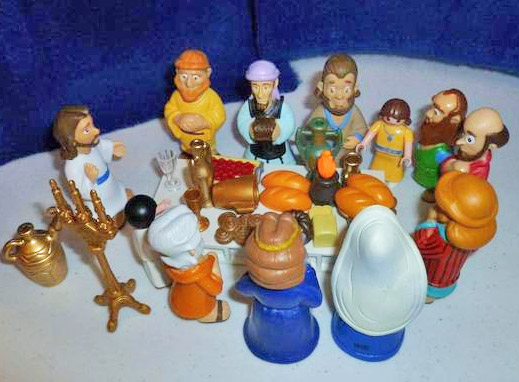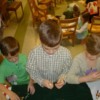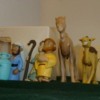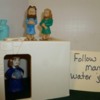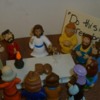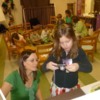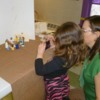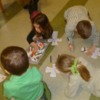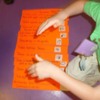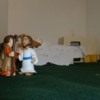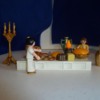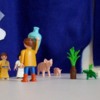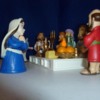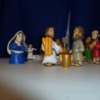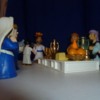The Last Supper
Drama Diorama "Story Table" Workshop
Summary of Lesson Activities:
Children will create and photograph a three-dimensional diorama of scenes from the Last Supper, using action figures and small props. The photos will be made into a slide show.
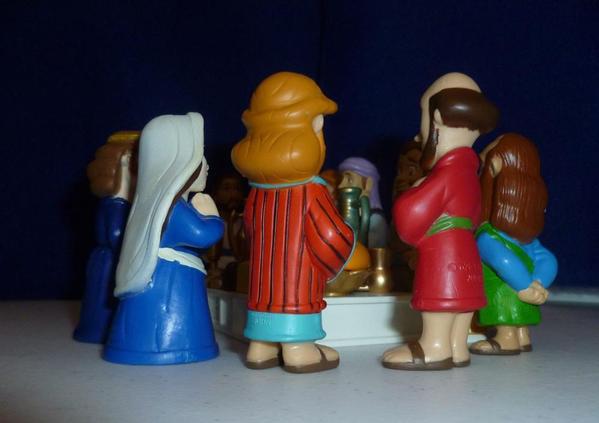 To view photos from this workshop, click on the first
To view photos from this workshop, click on the first
thumbnail image at the bottom of this lesson.
Learn more about "Story Table" or "Diorama" re-enactments in our Workshop training forum.
Scripture References & Memory Verse:
Refer to first post in this lesson set.
Important Note for Drama Workshop Leaders:
- Organize props and supplies before children arrive.
- Be sure that all children are involved in some way.
- Be sure to explain the activity to the children and ask for questions.
- Discussion is most effective when done during the activity. Feel free to pause and discuss details as they arise, add more information (using the Background information and resources) and answer questions along the way.
- The purpose of the activity is not to create a polished performance. Through the activity, children will explore the story in depth, learning as they play.
Preparation and Room Set Up:
- Review the Background Information and Lesson plan.
- Preview your chosen Music CD. Play the music as children arrive and during journaling.
- Gather the supplies for the scenes (we ordered people and props from Tales of Glory and Playmobil). We sorted the figures (animals, people, trees and vegetation, etc.) and put them in small plastic food storage tubs, then we put all of these items into a larger plastic bin.
Time Guidelines:
| Welcome and Introductions | 5 minutes |
| Bible study | 15 minutes |
| Create story diorama | 25 minutes |
| Closing | 5 minutes |
Supplies List:
- Tri-fold science board – 2 (inside and outside backdrops)
- Fabric to create backdrops (light blue, tan, dark blue/black – 1.5 yards each)
- Brown/green fabric for base of diorama.
- White or gold stars cut outs/stickers for night sky backdrop.
- Table
- Digital cameras.
- Optional: small tripod
- Mini-action figures and props (Playmobil, Tales of Glory figures, other props from small doll house type toys – plates, bowls, baskets, bread, goblets, trees, plants, table – can use wooden block)
- Science board and backdrop cloths prepared as noted above.
- Scene list
- Digital cameras
- Paper and markers to make speech “bubbles.”
- Scissors
- Tape
- Fine tipped markers (we realized that just using pens for the speech bubbles didn't show up very well in the pictures. Markers would have been better!)
Advanced Preparations:
- Select the mini-figures and props that relate to the story and sort so small pieces are contained. Leave the figures in the container until the activity part of the lesson.
- Set up the table and science boards with fabric for backdrops.
- Experiment with the camera to find the best “setting” and the best distance for photographing.
As children arrive, have them prepare the night sky backdrop – gluing stars to dark backdrop fabric. (Note: we ended up not doing this... )
LESSON
Early Arrival Activity – Review the Memory Verse:
Write the memory verse on a flip chart in the classroom. Recite the verse together several times. Black out one word at a time and continue to recite the verse, until all words are gone and children can recite the verse from memory.
Opening
Welcome the children as they arrive. Please wear a nametag and help the shepherds distribute nametags to the children. Begin each class with introductions. Tell the children that today they will be learning about Jesus’ last meal with his disciples before he was sent to die on the cross. They will be recreating some of the important scenes from the story using mini-action figures.
Opening Prayer:
Please begin each session with prayer. Amazing and Loving God, Thank you for all you have done for us, but most of all for loving us enough to send Jesus. This morning as we learn more about this very important time in Jesus’ life, help us to keep our eyes, minds and hearts open. Bless our time together. In Jesus’ name we pray, Amen.
Important Teacher Notes:
Each workshop includes the Bible story. One of our primary goals is to improve the children’s Bible literacy! If children did not bring their Bibles from home, use the classroom Bibles. Shepherds should help the children locate the stories. Use the Background Information to help you introduce the story.
Remember that as the rotation progresses; the children will become more familiar with the story. When this happens, allow the children to tell you what they know. The children should still locate the story in their Bibles every week. Use the bold headings in their Bibles to guide your discussion. You may want to review some of the Bible notes as well.Be sure to fill in any missing information and add additional details using the Background Information to help you. One of the greatest advantages of this model is that children who come regularly learn the story in great depth.
Each lesson contains more Background Information and discussion questions than can be used in one session. Remember, children are studying this story for four weeks! Be sure to follow the time guidelines and leave ample time for the activity.
Study the Story
Introduce the Story
Jesus spent three years with his best friends, his disciples. He taught them about God’s love and Kingdom, walked with them, ate with them and showed them great miracles. Many people followed Jesus because of the amazing things he did and said and because he showed them God’s love. But others did not love Jesus. Many of the religious leaders were angry with Jesus. They thought he was a false teacher. They were more interested in their religious rules than truly loving and caring for others as Jesus did. And so they planned a way to have Jesus killed.
Jesus knew he didn’t have much longer to live. He and his disciples were in Jerusalem for the Passover celebration. If you knew you were going to die soon, what would you do? With whom would you spend your last days? Jesus chose to spend his last night with his disciples, his best friends.
Bible Study: Grades K-2
The Picture Bible:
Where would we find a story about Jesus and his disciples in the Bible? (New Testament)
Help the children locate the story “Secretly in an Upper Room” and “The Lord’s Supper” page 641-645.
First Week – Briefly read/paraphrase the story as the children follow along in their Bibles. The scenes will be reviewed during the activity!
Subsequent Weeks – Have children find the story in their Bibles on page 641. Use the pictures in their Bible to review the story, asking questions about the pictures… For example:
- Who is in the first picture? What does Jesus tell the disciples to do?
- How would the disciples know where to go?
- Page 643 – Who is going to betray Jesus?
- Page 644 – What are they doing? What are they eating? What holiday are they celebrating?
- What does Jesus say that is new or different?
Be brief… the scenes will be reviewed during the activity!
Bible Study: Grades 3-5
NIV Adventure Bible
Where would we find stories about Jesus in the Bible? (New Testament, Gospels) The first four books of the New Testament are called the gospels. What does “gospel” mean? (good news – these books tell us the good news about Jesus).
Our story this month is found in all four gospels. What does that tell you about the importance of this story? (VERY important!)
We will review the story from the gospel of Mark. Help children locate Mark 14:12-25 in their Bibles. TIP: Find the NEW TESTAMENT quickly! (thanks for the tip, Carol Hulbert at First UMC Ann Arbor MI) Find Psalms in the Bible (Psalms is located about in the middle of the Bible). Now take the pages on the right hand side of the Bible and divide about in half; you should come to the Gospels – the first books of the NT (probably Matthew, the first book of the NT).
Before reading:
Present some KEY questions and encourage the children to listen closely so they will be able to answer these questions after reading.(you may wish to assign a question to each pair of children).
- Why were the disciples and Jesus in Jerusalem? (to celebrate the Passover)
- How did Jesus change the Passover celebration? What did he do differently?
- What do blood and lambs have to do with Passover? With Easter? With Communion?
- What does that mean for us as Christians today?
Ask volunteers to read Mark 14:12-25 as others follow along in the text. Rotate readers often. Pause to clarify and discuss while reading. Be sure children are familiar with the following:
- Passover (the special annual celebration of Jewish people to remember God’s mighty acts of saving them from slavery in Egypt. The foods that were served reminded the people of their experiences.)
- Blood of the Lamb and The Lamb of God (Recall the plagues on Egypt. Lamb’s blood was painted across the doorways so the angel of death would pass over that house and not bring death to the oldest son. The blood of the lamb wasused to save the children of Israel. When Jesus took the cup of wine and said, “This is my blood, shed for you”, he was telling us that his blood from his death would save us, just like the Passover lamb’s blood saved the Hebrew people long ago. John the Baptist called Jesus the “Lamb of God who takes away the sins of the world.” Jesus was the ultimate Passover Lamb!)
- Bread and Wine (when we take communionat church, what is the meaning of the bread and wine? (Jesus gave his life for each of us. The bread is a symbol of Jesus’ body. The juice is a symbol of Jesus’ blood. Blood is an important symbol for life in the Bible. In Old Testament times, the priests sacrificed animals and sprinkled the blood on the altar as they prayed to God for forgiveness. When Jesus died he was the perfect sacrifice – no other animals need to be killed to ask for forgiveness. Jesus took care of that once and for all! When we accept Jesus as our Savior and ask for forgiveness, God forgives our sins.)
- The rest of the story… The Last Supper was just one of many important events that happened during Holy Week. What happened after Jesus’ celebrated this meal with his disciples? (he prayed in the Garden, was arrested, tried, crucified, buried and ROSE ON THE THIRD DAY!)
Memory Verse:
Each rotation we encourage the children to memorize the Rotation Memory Verse. Review it with the children at this time.
“This is my body given for you) Do this in remembrance of me.” Luke 22:19
Jesus told his disciples to remember him whenever they eat bread and drink the wine (juice). Each time we take Communion in church we can feel especially close to Jesus. We remember Jesus and how he lived and how he willingly died so our sins could be forgiven and we could be friends with God forever.
Last Supper Diorama:
(Activity developed from an idea described by Luanne Payne, Hampton United Church, Ontario Canada) Go to this link to read more about this type of workshop.
Directions:
- Gather the children around the table where the backdrops have been set up.
- Explain that they will work together to recreate several diorama scenes portraying the story and photograph each scene – these will be made into a slideshow or video.
- Demonstrate proper use of the camera. Place the camera at the level of the figures and close up. Take a few sample pictures.
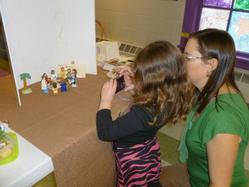
- Show the scene list.
- If the class is large, you may have to assign scenes to small groups of children and have them take turns. There are several tasks: set up the scenes, create the speech/thought bubbles, photograph the scenes. Children should alternate roles.
- Have the children use the figures, props and backdrops to set up the diorama for each scene. Have them think about: where the scene takes place (outside, inside, daylight, night) and how best to show that (using different backdrops, props, etc.)
- For older groups: If dialogue or thoughts are important to the scene, have the children write these out on paper and tape to the backdrop for each scene. Once the scene is ready, allow the children to take photographs of the scenes. (be sure to check the photos before changing scenes to make sure the photos are focused) Have the shepherd use a different camera to take pictures of the children as they work.
- Repeat with the other scenes, changing backdrops and figures as appropriate.
- Encourage discussion of the story during scene creation and re-enactment.
Adaptation for younger children: Younger children may need more assistance with photographing and setting up the scenes. You may also create fewer scenes – for example: finding the man with the jar, celebrating the Passover, Jesus saying “Do this in remembrance of me.”
For younger children: set up the scenes and include a title card (cardstock folded over in tent fashion) to describe each scene.
NOTE: We realized after the first session (where we had about 15 kids) that to control the creative chaos, we would need to limit the number of kids working at one time. For the second session, we had 2-3 children come up at one time and create a scene while the others worked in journals, reviewed the memory verse, sequenced the story with story strips and did a fuzzy cross Holy Week coloring that we purchased from Oriental Trading. Once the scene was completed and photographed, we invited the others up to look at it and guess the scene. Worked MUCH BETTER!
Scenes (for older groups):
- Jesus and Disciples: What did the disciples ask? (Where should we go to make preparations for the Passover?)
- How did Jesus answer them? (Two disciples sent into city – find a man carrying water jar, follow him and ask the owner of the house… the Teacher asks, where is the guest room where I may eat the Passover with my disciples – the room will be ready)
- What were the disciples to do next? (Prepare for the Passover there – set out the food, plates, cups, etc.)
- Jesus arrives with other disciples (when – evening)
- Jesus and his disciples eat the Passover meal together.
- Jesus announces one will betray him. (What was the sign? The one who dips bread into the bowl with Jesus)
- Jesus gives new meaning to the Passover meal. What does he do? (Takes bread, blesses it, says, “This is my body. Takes cup of wine, blesses it, gave it to them saying, “This is my blood of the covenant, poured out for you. Do this in remembrance of me!)
- Jesus and disciples sing hymns together.
Scene Titles (for younger groups)
(Write these out on cardstock tents and place in front of each scene.)
- “Where shall we celebrate the Passover?
- “Go to the city and find a man with a water jar. Follow him.”
- Eating the Passover.
- “Someone will betray me.”
- “Do this in remembrance of me.
Discussion:
What is the rest of the story? (Jesus prayed in the garden, was arrested and beaten, then crucified, died and buried in a cave. On the third day, what happened? (HE ROSE from the dead and is alive today!)
If time allows, show the pictures to the children.
Create the Slide Show/Movie:
After the sessions are completed, insert the photos into a power point slide show. Add print scene titles to each slide if desired. Show the slide show to families and children – possibly during Holy Week or on Easter Sunday. One option would be to have older children do this!
Journal Reflection (Optional)
The last ten minutes should be reserved for journal time. This is an opportunity for processing and reflection about what the children have learned. Ask the shepherds to pass out the journals and pens/pencils. Place the journal question sticker for the day in each journal.
Journal Questions:
Grades K-2: Draw a picture showing a way you can remember Jesus.
Grades 3-5: What from today’s lesson will help you remember Jesus the most?
Closing:
Encourage the children to come back next week for another workshop, and to invite their friends. Remind the children of one word or concept from today’s session. Communion, remember, God’s love, sacrifice, Jesus, Passover Lamb are some possibilities. Ask for prayer requests and pray together, ending with the Lord’s Prayer.
Clean-up:
Help Shepherd collect Journals and nametags and put away. Return all action figures and props to the container for safe keeping.
A lesson written by Jaymie Derden from: State Street UMC, Bristol, VA
Click on any one of these pictures shown below, to start up a slideshow of all of the pictures. (Move from picture to picture by using your keyboard arrows.)

